PORTMAN ELECTRONICS GST-8000 GST8000 GPRS / GPS TRACKING SYSTEM User Manual gst8000 v2 0 1
PORTMAN ELECTRONICS (DONGGUAN) CO., LTD. GST8000 GPRS / GPS TRACKING SYSTEM gst8000 v2 0 1
manual

Portman Security Systems, Ltd
Operation Manual
GPRS / GPS TRACKING SYSTEM
Model: GST8000
Version 2.0

1
I. INTRODUCTION
PORTMAN GPS GPRS Tracking and Alarm System utilize the GPS and car alarm
functions in one unit. You can monitor the vehicle location and control the car alarm
remotely. In addition, the unit will send event report if any trigger occurs. It has built-in 3
outputs and 5 inputs to perform essential alarm functions. Tri-communication capability
through SMS, GPRS and SBD (Iridium’s short burst data). Tri-communication switch
automatic. Communicate with Iridium’s satellite where no GSM coverage.
1.1 Report structure
The standard report sent by the unit includes the information: (1) unit’s ID, (2) status, (3)
time, (4)GPS’s latitude and longitude, (5)speed, (6) direction, (7)temperature, (8)device’s
status, (9)event number, and (10) report configuration parameters.
(1) Unit’s ID: each device has its own unique ID and must be registered in the server in
order to perform monitoring or controlling.
(2) Status: ‘A’ mean the number of satellite is more than 4 or equal to 4; ‘B’ mean the
number of satellite is equal to 3, ‘L’ mean the number of satellite is less than 3.
(3) Time: report time in Greenwich Mean time zone.
(4) GPS’s latitude and longitude.
(5) Speed: in km/H
(6) Direction: in degree to the North.
(7) Temperature: in Celsius. If the temperature is not connected, ‘NA’ will be shown in
this field.
(8) Device’s status: there are 32 states to represent the I/O and working modes for the
both the device and the build in alarm.
(9) Event number: all the generated reports will include a unique event number to
indicate why it has been sent.
(10) Report configuration parameters: user can remotely change the report configuration,
and the configuration parameters will be shown in this field.
1.2 Report Setup
GST8000 must be initialized by PORTMAN PC setup program in order to make
communication with the remote server /call center. There are 9 main sections that allow
users to program the device, (1) User detail (Device ID, server IP, and port, SMS number,
GPRS APN…) (2) In-built Geofence definition (up to 1 self geofence, 4 circular geofence,
5 rectangular geofence and 20 point Geofence shapes can be set in the device) (3) Report
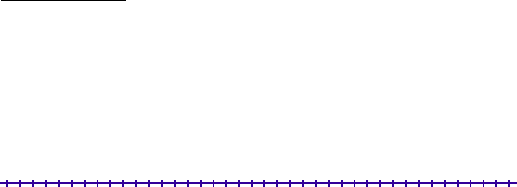
2
setting (Time, Distance, Intelligent mode, Temperature, Low battery, Course change…)
(4) Roam report setting (Time, Distance, Intelligent mode, Temperature, Low battery,
Course change…) local or send or ignore. (5) Alarm setup (to enable or disable the event
generated by the inputs or external alarm, e.g. ignition, DOOR, ALARM...) (6) Roam
Alarm setup (to enable or disable the event generated by the inputs or external alarm, e.g.
ignition, DOOR, ALARM...) local or send or ignore. (7) GSM Roaming (Roaming GPRS
Mode setting, Compress setting…)(8)SBD Setting (SBD report, Check SBD, Power
Management setting…)(9) ID Card learning…)Those data is saved in device’s EEPROM
and will not be lost even if the power is failure.
Note that the device ID, GPRS APN name, GPRS login name and password need to be set
in initial PC setup in order to make the connection to the server. All the reports
configuration or Geofence setup can be changed at anytime via over the air commands. The
automatic reporting mode can be categorized as ‘time’ report, ‘distance’ report, or ‘time &
velocity’ report. User can choose the reporting mode and related parameters via the PC
setup program or the remote sever.
The event trigger report is also configurable. User can turn on or off any event generated
report from the PC setup program or via the air command. The event triggered report
include (1) In-vehicle Door close/open (2) In-vehicle ignition on/off (3) AD input (4)
In-vehicle shock sensor trigger.
The server can not only configure the device just like the PC setup program does, but it also
can send the command to control the device. The server can control both the device and the
build in alarm.
1.3 Geofence function
The device has built-in 30 Geofence sets (1 immediate geofence, 4 circular, 5 rectangular
and 20 point), it will send the report to the server if the Geofence event is triggered. User
can setup the Geofence area from the PC setup program or sending the define.
A unique immediate Geofence function:
‘Immediate-Geofence function’ is a circular type Geofence which can be activated or
deactivated from a single button. When activated, the system will record the current
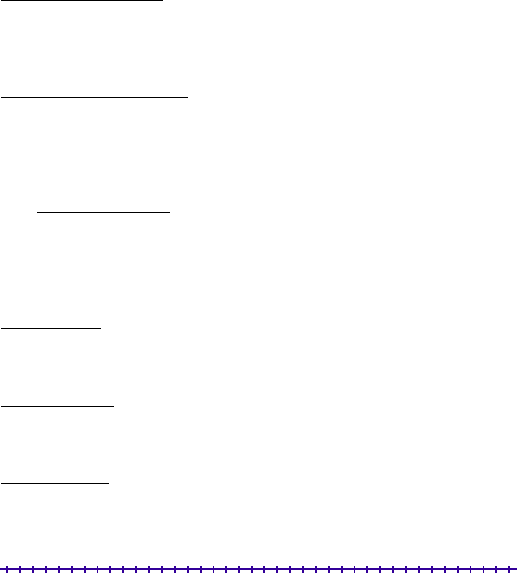
3
position and use the pre-defined radius as a circular Geofence to guard the vehicle. If the
vehicle moves out of the preset Geofence zone, a report will be generated to the server.
User can deactivate the self-Geofence at any time by pressing the button again. If the GPS
cannot be located when the Immediate Geofence function is been executed, GST8000 will
used the last known position as the origin of the circular Geofence zone to perform the
protection.
1.4 Store and forward ability
When there is no GPRS service or the server close. The unit will send short message to the
server if defined SMS number. All the stored report will be forward to the server when
GPRS connection is completed next time.
1.5 TCP and UDP socket support
GST8000 supports both UDP and TCP socket communication. The server IP, port number
and socket type can be selected from the PC-setup program or remote server command. In
addition, the connection can be swap over to any server IP or port (either UDP or TCP) via
the air command.
1.6 Valet switch operation
User can use the supplied Valet switch to perform 7 essential tasks, including (1) sending
help report (2) activate or deactivate Immediate Geofence (3) sending ‘Duty on’ or ‘Duty
off’ report to the server (4) Emergency release to exit ‘ARM’, ‘Anti-carjacking’ or ‘Panic’
modes
1.7 History report
Flash memory for recording reports up to 900 reports. It can be read out from the PC setup
program via serial port.
1.8 Backup battery
The system has a built-in rechargeable battery (12V 1.3A/H) for emergency use. The
system will send a power cut report when all the external power are disconnected.
1.9 LED indication
Three LED indicate the status of the POWER, GPRS signal and GPS signal.
The LED on the valet switch or keypad can also indicate the status of the button operation,
e.g. sending help report, panic report, …

4
1.10 Keep alive procedure
Keep alive procedure (in order keep connection in GPRS network, the unit can be set to
send short keep alive report to the server in order to prevent the disconnection from the
mobile service provider)
1.11 Sleep Mode
The Sleep Mode:
For long periods of inactivity user have the options to set the unit in sleep mode this will
enable the unit to save electric power.
GST8000 Can go to sleep mode when ignition goes off, TL-sensor not be trigger for
5minuts and this feature is configurable. “GPS” can be power off. User can setup the
automatically wakeup time during the sleep mode to ensure the device is working. The
system can send out a diagnostic report to the server after waking up.
During the sleep mode, if any of the inputs are triggered, the system will wake up and send
relevant reports to the server. The input triggers for waking the device up are selectable.
When ignition is on, the system will back to working mode and stay connected to the
TCP/UDP server in GPRS network.
1.12 Iridium satellite short burst data support
GST8000 support satellite short burst data. While there is no GSM coverage, Iridium
satellite module start communicates with server. Unit sends compressed report to server,
and server can send command to control or configure unit.
GST8000 supply special PC SETUP table for Iridium satellite module, satellite module
report includes special fix time, fix distance, intelligence, help and power cut report.
II. BASIC FUNCTIONS
FUNCTIONS APPLICATIONS
GPS GPS receiver will output a complete position, velocity, and time
(PVT) solution in the NMEA Version 3.0 protocol
GPRS, SMS GPRS use standard TCP or UDP communicate protocol. If the GPRS
service is failed, the SMS mode will be turned on for emergency use.
Satellite SBD If no GSM network coverage, Satellite will start work with SBD
configuration.
5 input
In-vehicle Door.
In-vehicle ignition
Valet switch port

5
AD1 input
AD2 input
3 output
1. Door Lock
2. Door Unlock
3. Coil (for E-card searching)
GPS output interface GPS port will output NMEA 0183 GPS data.
Data rate: 9600 bps
Valet Switch (1) Send help report (2) activate or deactivate Immediate Geofence
PC-setup
Initialize the unit and program the device, including Network APN,
server IP address, user message, report control, and Geogence
setting, etc …
Note that Network APN and server IP details must be set before the
installation.
Standard Report
Automatic report for AVL tracking purpose:
Fixed time report
Fixed distance report
Intelligent report (combine time and distance)
Keep alive report
Event Report
Temperature report
Speeding report
Low battery report
Geofence trigger report
Wake up report
ALARM trigger report, e.g. ARM, ignition inputs, etc …
History data store 900 report can be saved in unit, and read from server and pc-setup
Valet switch OPERATION
(1) Sending help report
Press the button once, The LED will flash once and a help report will be generated.
(2) Activate or deactivate Immediate Geofence
Press the button and release it when the LED flashes once. After releasing it, the LED will
stay continuously on to indicate the ‘Immediate Geofence’ is on. To deactivate: Press the
button (the LED will be temporally off), and release it when the LED flashes once. After
releasing it, the LED will then stay continuously off. A report will be sent out if the vehicle
goes out/in to the Geofence zone.

6
(3)ID CARD learn mode:
Turn ignition ON, press Valet Switch 12 times within 10 sec, the valet LED will keep on for
1 second to enter ID card learning mode, the new ID CARD can be learn in this time. If no
ID card can be learn during 10 seconds, unit will exit ID card learning mode. During the
learning process, the valet LED flash quickly.
(4)Emergency release:
Press valet switch for 6 times, LED will keep on, then unit will enter Emergency release
MODE,the LED will flash slowly.
LED flash N time and press valet switch to confirm the first digit of password, then confirm
the other 3 digit password in turns. While the password input finished, the unit will
emergency released or 1 minute later the unit will overtime exit.
III. STATUS INDICATOR
System LED:
RED: Power indicator. When the unit power on, the led will light all the time. When power
cut off the unit works with backup battery, the led will flash until all the report is sent to
server.
While satellite module works fine, red led flash twice every 2 seconds.
YELLOW: GSM/GPRS indicator. Yellow LED will flash when the device is connected to
the server with valid GPRS connection. It will stay continuously on when it is in GSM
mode. It will stay off if there is no GSM reception.
Green: GPS indicator. This LED will be ON when the unit received a valid GPS data.
Note that the Green LED indication will not be valid until the system goes to the working
mode, normally 30 seconds after power on.
PC SETUP AND SYSTEM INITIATION
PC setup Procedure:
(1.) Connect the 4pin to USB cable to the DB9 port.
(2.) Open the PC setup program.
(3.) Select the correct COM port for communication.
(4.) Power on the device or press the reset button until red LED turn off.
(5.) Click “ok” to start the program
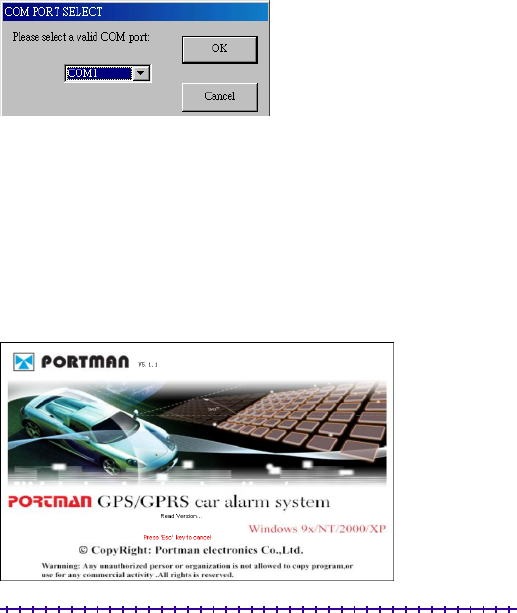
7
Note that, if the connection fails, please check the cable connection is secured correctly.
Press the reset button for a longer time, e.g. another 3 seconds.
A. LOGIN dialog window
Select the correct COM port number, then “reset” the unit by pressing the reset button, and
next click “OK”.
Note that: it is necessary to power on and reset the PORTMAN device soon after click the
“ok” button.
PC setup program will detect the hardware for 60 seconds. If no hardware is detected, it
will exit.
During the opening up screen shown as below, user can press “Esc” key to terminate the
program.
B. Version No. Checking
The below interface will last until correct UNIT Version No. is checked. (You should run
this program before turn on power of UNIT)
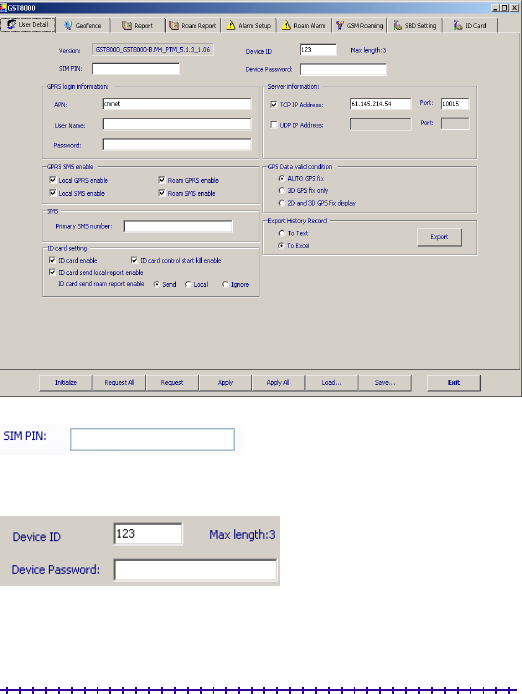
8
C. MAIN INTERFACE
1. [User detail:]
If the SIM card is password protected, user can input the “SIM PIN” window to set
password of SIM Card.
Set UNIT ID and UNIT password of for the device.
Note: Device ID length does not more than 4-characters, otherwise SBD compressed packet
will more than 30 bytes, and communication data fee is double.
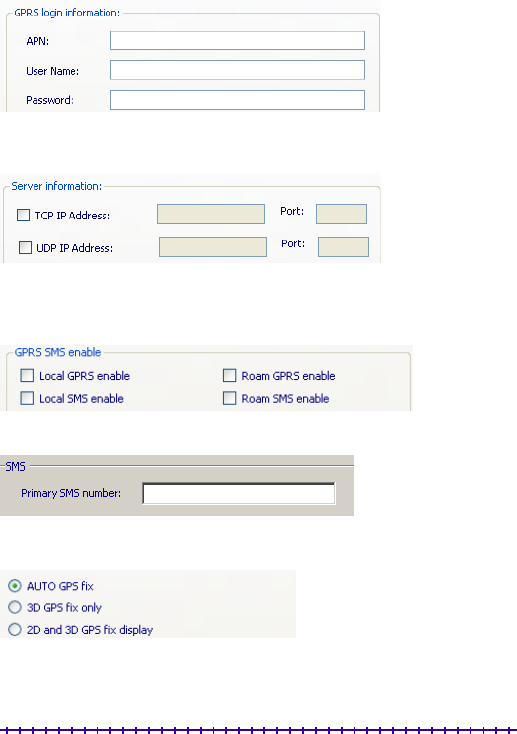
9
Set Access Point Name (APN), User Name, Password. The maximum length of the APN,
User name and Password is 49 characters.
TCP/UDP address and Port number of the remote server being set, UNIT will send report to
these address.
Note that only one TCP or UDP server will be used at the same time.
To select enable or disable local GPRS/SMS or Roam GPRS/SMS
Set the SMS Number of the user. The unit will send reports to the user if GPRS connection
is failed.
AUTO GPS fix: the report will be display “A” in the report and indicate that if the number
of satellite is more than 3 or equal to 3. If the number of satellite is less than 3, then it will
show “L” in GPS fix section.
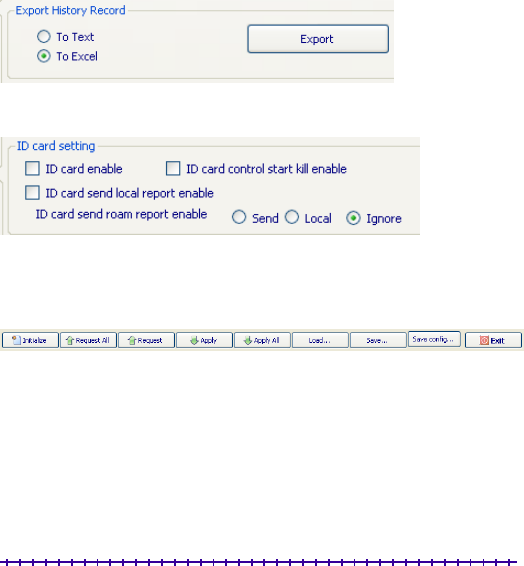
10
3D GPS fix only: the report will be display “A” in the report and indicate that if the number
of satellite is more than 4 or equal to 4. If the number of satellite is less than 4, then it will
show “L” in GPS fix section.
2D and 3D GPS fix display: the report will be display “A” in the report and indicate that if
the number of satellite is more than 4 or equal to 4.
If the number of satellite is equal to 3, then the report will show “B” in GPS fix section.
If the number of satellite is less than 3, then the report will show “L” in GPS fix section.
UNIT can save 900 reports (900-1) recently; Click ‘Export’ button can export them with
Excel or Text format.
To select ID-card enable or disable, ID-card control start kill enable or disable, ID-card
send report enable or disable.
If “ID card control start kill enable” was selected, the unit will disarm by ID-card only or
emergency release.
“Initialize ” button: clear all data in UNIT.
Request All: read out the whole existing setting from GST8000.
Request: read out the setting in the current page.
Apply: transfer the setting to GST8000 in the current pages.
Apply All: transfer the whole setting to GST8000.
Load: load the saved configuration files.
Save: save the current configuration setting to a file.
Save config: save the current setting to a config file
“Exit ” button: exit PC-Setup to main program.
Note that Device ID, GPRS Login and server IP/Port information need to be input correctly
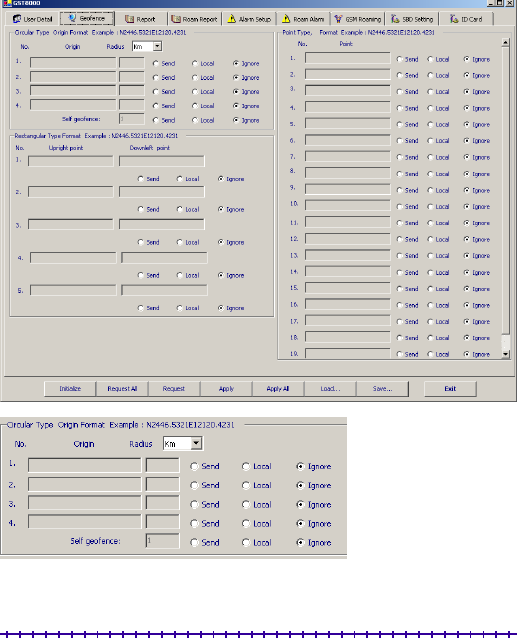
11
in order to make the connection. If the report sending using GPRS connection fails, the
report will be sent to the ‘primary’ SMS number first. The report will be resent, when the
GPRS connection becomes available.
2. [Geofence:]
Four Circular Geofence and one self-geofence:
Circular Geofence must set origin and radius:
Origin format :N2446.5321E12120.4231;
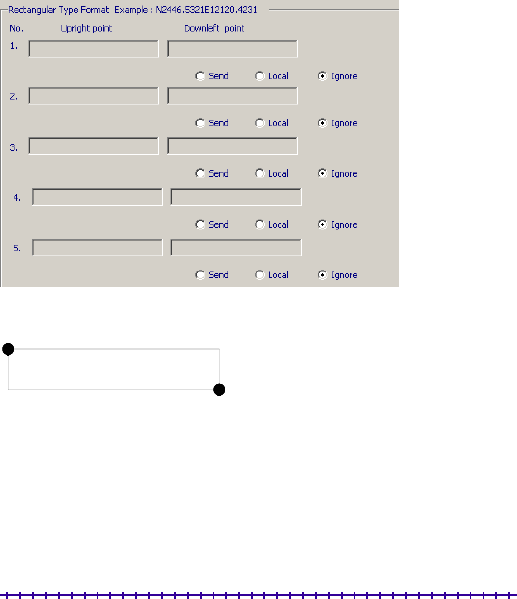
12
N2446.5321 is latitude, E12120.4231 is longitude.
Radius from 0.1 km to 1000km.
User can set the reports send or local or ignore:
Send: report will send out immediately if generation
Local: report will save if generation, it will send out by local network
Ignore: cancel reports.
Five rectangular geofence:
Set two points position, the point format is N2446.5321E12120.4231;
With two points, generate one rectangle. Unit will detect whether in rectangle. When unit
enter or leave rectangle, will send one message out.
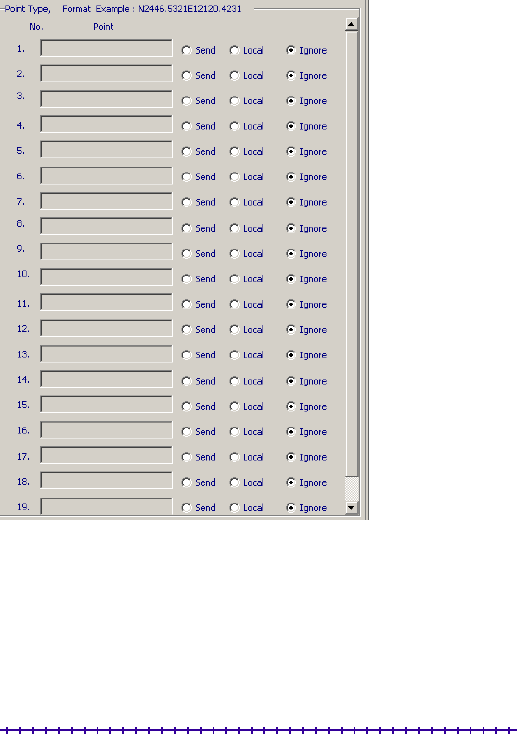
13
20 point Geo-fence areas can be set. When UNIT is out of these predefined zones, a report
will be generated.
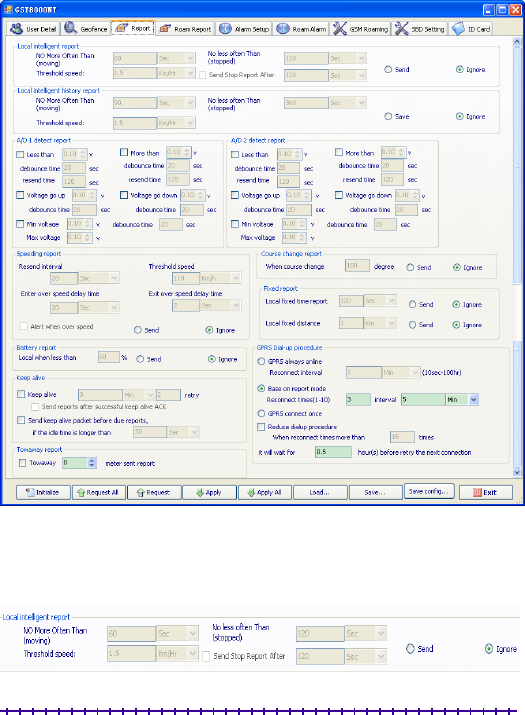
14
3. [Report:]
Automatic report can be configured in this section. To activate the function(s), please select
“√” in checkbox and fill in data in the textbox.
The reports will be summarized as
(1) Local Intelligent report
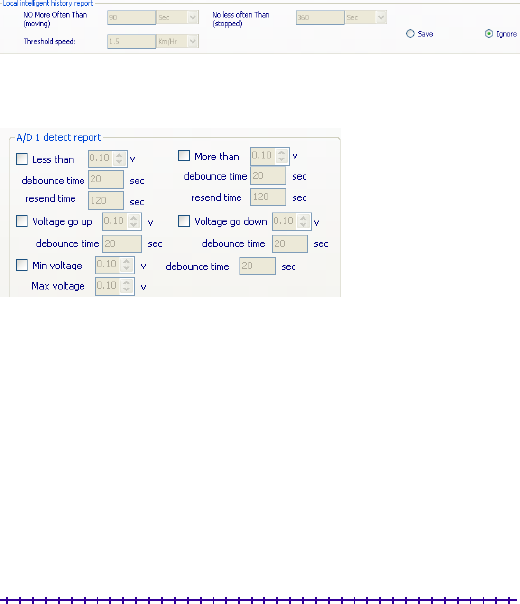
15
Parameters: report time when moving, report time when stop, threshold speed, send stop
report after a preset value and to choose the reports send or ignore.
Report when speed less than a preset value (refer the following 1.5 Km/Hr), and it will send
stop report after the preset time (refer the following 120Sec). (min. speed is 0.1 km/Hr, max.
speed is 1000 km/Hr).
(2) Local Intelligent history report (record the report in the system’s flash ram)
Parameters: Report time when moving, Report time when stop, and threshold speed. (min.
speed is 0.1 km/Hr, max. speed is 1000 km/Hr). and to choose the reports send or ignore.
(3) A/D 1 detect report
[on/off] SEND REPORT IF ADC1 LESS THAN [min voltage] V for [debounce time] SEC,
RESEND PER [resend time] SEC
[on/off] SEND REPORT IF ADC1 MORE THAN [max voltage] V for [debounce time]
SEC, RESEND PER [resend time] SEC
[on/off] SEND REPORT IF ADC1 GO UP [up voltage] V for [debounce time] SEC
[on/off] SEND REPORT IF ADC1 GO DOWN [down voltage] V for [debounce time] SEC
[on/off] SEND REPORT IF ADC1 ENTER/EXIT [min voltage] V TO [max voltage] V for
[debounce time] SEC
Note: AD1 input voltage range is 0~3.30v, it must connect a resistance to share the voltage
if the detected voltage higher than 3.30v.
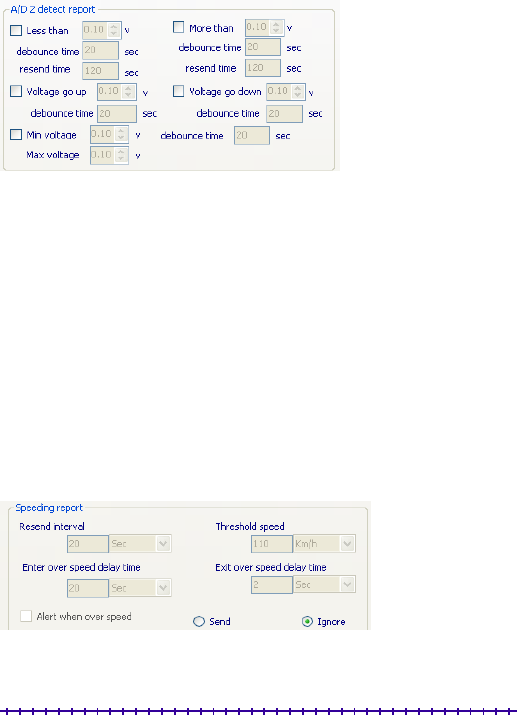
16
(4) A/D 2 detect report
[on/off] SEND REPORT IF ADC2 LESS THAN [min voltage] V for [debounce time] SEC,
RESEND PER [resend time] SEC
[on/off] SEND REPORT IF ADC2 MORE THAN [max voltage] V for [debounce time]
SEC, RESEND PER [resend time] SEC
[on/off] SEND REPORT IF ADC2 GO UP [up voltage] V for [debounce time] SEC
[on/off] SEND REPORT IF ADC2 GO DOWN [down voltage] V for [debounce time] SEC
[on/off] SEND REPORT IF ADC2 ENTER/EXIT [min voltage] V TO [max voltage] V for
[debounce time] SEC
Note: AD2 input voltage range is 0~3.30v, it must connect a resistance to share the voltage
if the detected voltage higher than 3.30v.
(5) Speeding report
Parameters: resend interval, threshold speed, over speed delay time, exit over speed delay
time, alert when over speed and report send or ignore
For example, if resend interval is 20 sec, enter over speed delay time is 20 sec, threshold
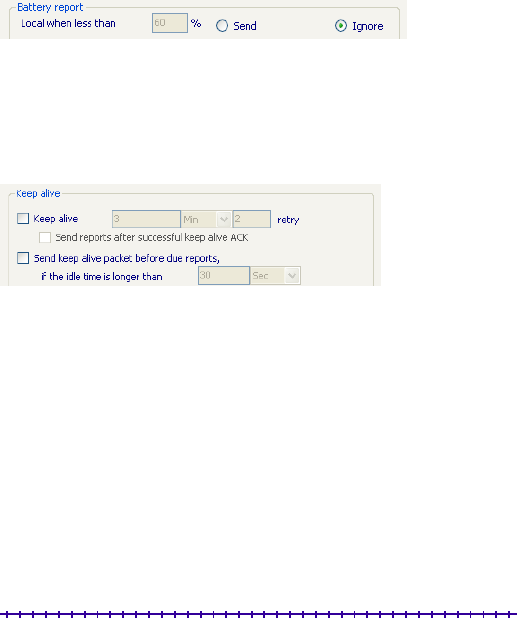
17
speed is 110Km/h and exit over speed delay time is 2 sec.
If vehicle speed over threshold speed 20seconds, system will send speed over report once
interval 20 sec until exit speed over delay time 2 sec, the over speed report will stop to send.
If alert when over speed has configured, then it will alert when speed over.
(6) Low battery warning report (to alert user when the external battery level is low)
Parameters: warning battery level for report and report send in time or send by local
network or ignore.
For example, 50 to represent 50% lower level report.
The system will ignore the parameter with a value ‘0’ to prevent continuous non-stop
reporting.
(7) Keep alive
Parameters: On/Off, and interval / retry times. In order to keep connection in GPRS
network, the unit can be set to send short keep alive report to the server in order to prevent
the disconnection from the mobile service provider.
Send reports after a successful keep alive ACK. Parameters: On/Off .
If you select this function, all the reports will only be sent out after a successful keep alive
ACK. (So if your keep alive time is shorter then select this function will be OK.) This
function is very useful while using UDP to prevent report lost.
Send a keep alive packet right before a due reports if no data stream within certain time:
Parameters: On/Off, and idle time.
Some GSM provider might cut connection, if there is no data within certain time. It might
result report lost in this “fake connection” duration. For example, you can set parameters in
this region, ex 20 mins. (it means if the unit did not send any data in this 20 mins (including
keep alive or normal reports) ), then it will send a keep alive packet to check if the GPRS
connection is valid or not. If not, it will actively reconnect to GPRS network.
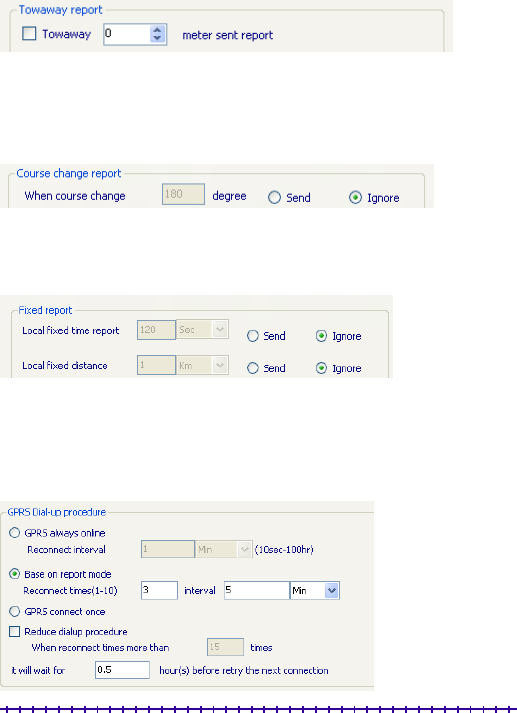
18
(8) Towaway report
When system in ignition OFF mode, if the vehicle has been towed away, unit will sent a
towaway report.
(9) Course change report (to send a report when the course change is bigger than the value
set here)
Parameters:
Course change in degree and report send or ignore
(10) Fixed report
Parameters:
The time of local fixed time report and report send or ignore.
The distance of local fixed distance report and report send or ignore (min. distance is 0.1
km, max. distance is 100 km).
(11) GPRS Dial-up procedure

19
1) GPRS always on-line
Parameters: Reconnect interval
While using this mode, when the unit can not searched GPRS signal, system will reconnect
GPRS interval a preset value. (e.g.: 1minute)
2) Base on report mode
Parameters: Max. reconnect times, reconnect interval
While using this mode, the unit will connect to the server when there is a report to send. If
the first connection is failed, it will retry to connect to the server up to the max. reconnect
times. Each retry will be separated by the reconnect “interval”.
3) GPRS connect once
While using this mode, the unit will connect to the server when there is a report to send (but
only try once). If it is not successful, the report will be stored and sent out in the next
successful connection. Disconnect GPRS connection when report sending is completed.
4) Reduce GPRS dialup method
Parameters: On/Off, Max. reconnect times, connect delay
If this method is used, the unit will reduce the GPRS dial-up connection when the dial-up is
failed after number of times. User can define the delay time for the unit before try to
reconnect to the server. If there is trigger report, the unit will connect to server immediately.
Special command for SMS mode:
If the GST8000 is not in the GPRS online status, user can send command &&Y02 or
&&Y04 to ask unit to connect to server. This command can be sent from any device via
SMS;
&&Y02:
When received this command, system will actively try to connect to server in next 600
seconds.
&&Y04,[connection time],[report interval]:
For example: &&Y04, 3600, 60
When received this command, system will connect to server in the next 3600
seconds, and send one report out every 60 seconds.
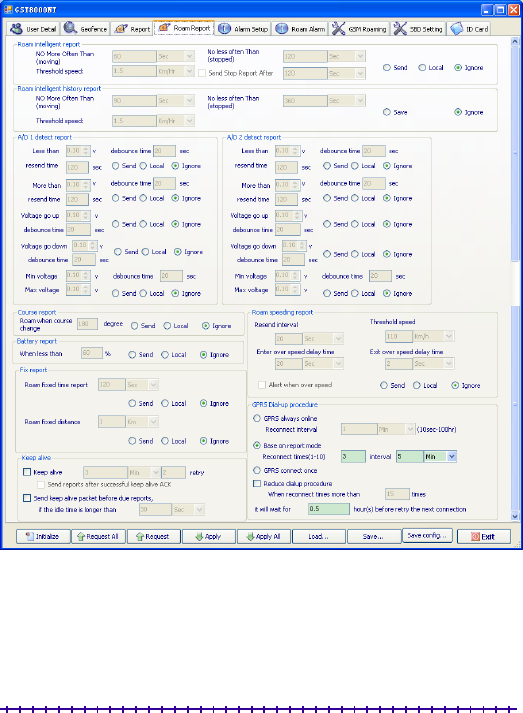
20
4. [Roam alarm]
All the roam reports configured are same as Local report.
Send: report will send out immediately if generation
Local: report will save if generation, it will send out by local network
Ignore: cancel reports.
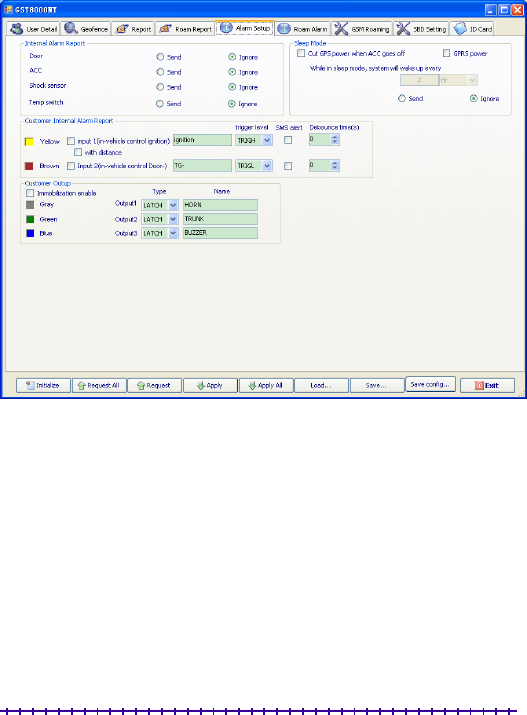
21
5. [Alarm setup]
Alarm report(s) is also configurable. User can customize the events generated by the
in-vehicle input or build in car alarm to be sent to the server. If the item(s) be selected
(VALID), the related reports will be sent. Otherwise the report will be ignored even when
an event is occurred internally.
Also build in car alarm function can be set on here.
Sleep mode (when ignition OFF)
(1) GST8000 can go to sleep mode when ignition goes off and TL-sensor not be trigger for
5minuts. In sleep mode, GPS will be disabled.
All the auto report (Time, Distance, Intelligent…) will not be send when ignition goes off.
(2) During the sleep mode, the system can wait up automatically and send a wake up
diagnostic report. The automatic wakeup time is configurable. (Minimum duration is 5
minutes; maximum duration is 1000 Hours).
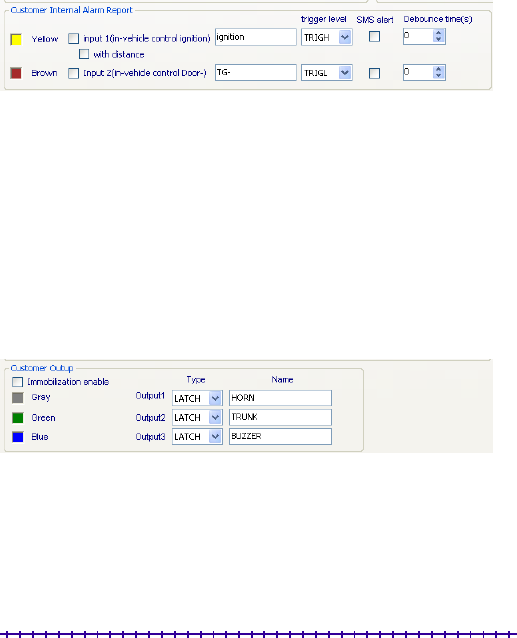
22
(3) If any of the inputs are triggered while in the sleep mode, the system will wake up
automatic and then send reports to the server. The input triggers for waking the device up
are selectable. If the GPRS connection is failed, for emergency purpose, GST8000 will
send out SMS report if number is defined.
The input events can be changed to trigger on low or high, by using the TRIGL or TRIGH
command
TRIGL: TRIGL will set the input to trigger on LOW (ground)
TRIGH: TRIGH will set the input to trigger on HIGH (12V)
SMS alert: when the item(s) were selected (valid), the related reports will be sent by SMS.
Debounce time(s): the delay time for report sending.
If input 1 with distance is selected, system will send the distance report every time ignition
ON to ignition OFF, for example: %%GST8000,A,03,
070521024400,N2240.8929E11359.2030,000,270,NA,D7000000,254,CFG:5:00
CFG:5:00 is the time from ACC ON to ACC OFF.
User can set the output enabled with LATCH or PULSE or CYCLE.
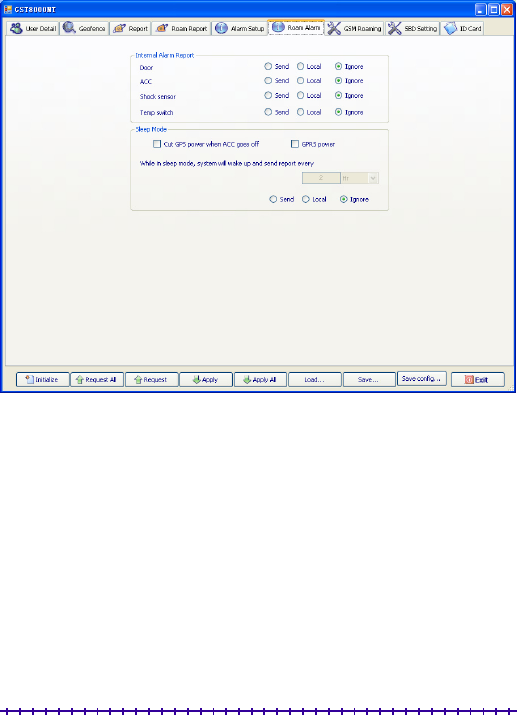
23
6. [Roam alarm]
All the roam alarm configured are same as Local report.
Send: report will send out immediately if generation
Local: report will save if generation, it will send out by local network
Ignore: cancel reports.
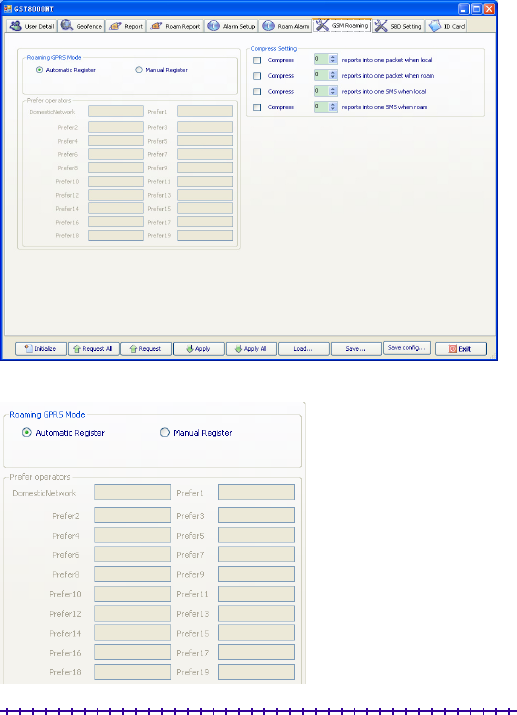
24
7. [GSM roaming]
1) Roaming GPRS mode
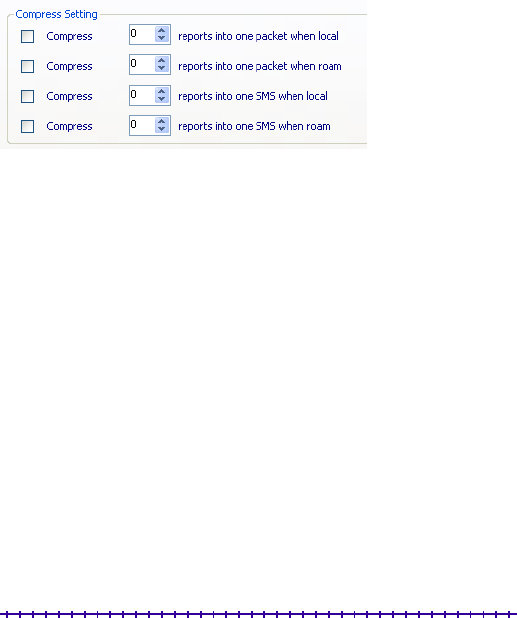
25
Use can configure roaming GPRS mode with automatic register or manual register in this
field.
When roaming GPRS mode in manual register, user can set 20 prefer operators, main unit
will search and register from the 20 prefer operators.
2) Compress setting
1. To send report in local GPRS, compressing N reports to a packet and then send
out.(N: the digit between 1~8)
2. To send report in roam GPRS, compressing N reports to a packet and then send
out.(N: the digit between 1~8)
3. To send report in local SMS, compressing N reports to a SMS and then send out.(N:
the digit between 1~4)
4. To send report in roam SMS, compressing N reports to a SMS and then send out.(N:
the digit between 1~4)
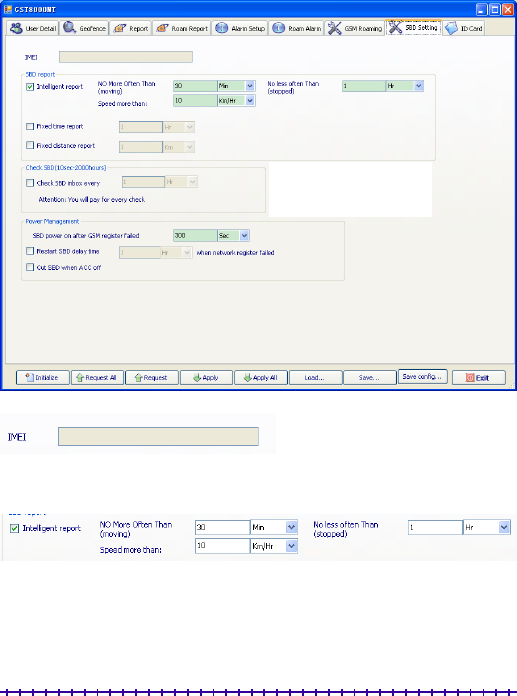
26
8. [SBD setting]
IMEI: Any operate with ‘request or request all’ after GPRS power on, the module series
number will display automatically, otherwise it displayed with space.
This report is special for satellite module. It is different to intelligent report defined in
common report setting.
This report only work when no GSM coverage.
Attention: because consumption with satellite is different to GPRS/SMS. Pay attention to
report frequency.
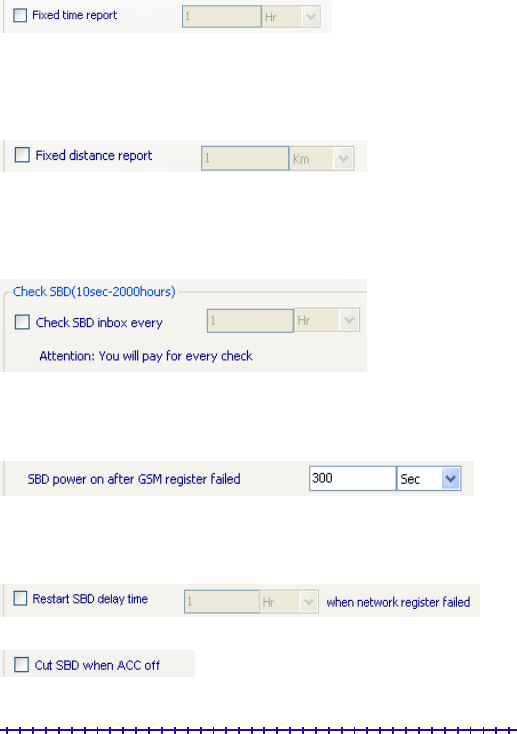
27
This report is special for satellite module. It is different to fix time report defined in
common report setting.
This report only work when no GSM coverage.
Attention: because consumption with satellite is different to GPRS/SMS. Pay attention to
report frequency.
This report is special for satellite module. It is different to fix distance report defined in
common report setting.
This report only work when no GSM coverage.
Attention: because consumption with satellite is different to GPRS/SMS. Pay attention to
report frequency.
Set time how often to check inbox. After get command from server, unit will analyze
command and feed back.
Attention: User must pay for every time to check SBD inbox.
Besides actively check inbox, satellite check inbox once while send report to server.
Set delay time before satellite module power on.
After unit detected GSM register fail, unit need a little time to confirm GSM signal lost
really, Then power on satellite module.
This period is used to avoid satellite module frequency power on/off.
Set idle time. When satellite module registers fail, it will go to idle mode.
Selection whether cut SBD power when ignition off. If unit go to sleep mode, SBD power
will be cut.
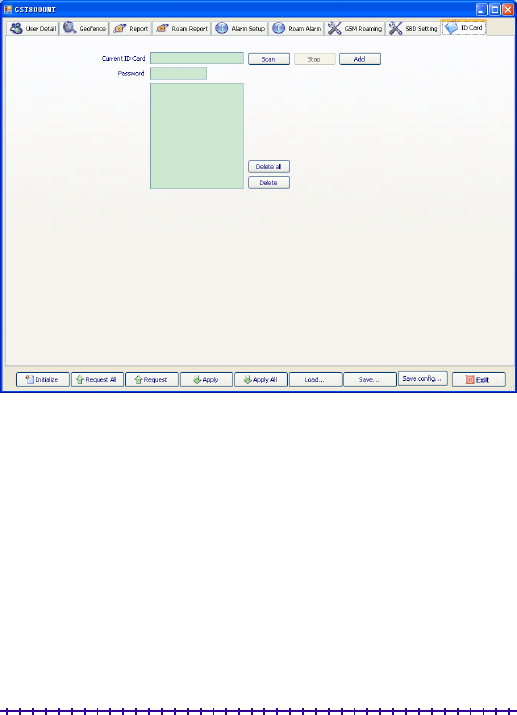
28
9. ID card
ID card learning function:
1. Press ‘scan’ and put the ID card near coil
2. The unit will read ID card number and display in here
3. Press ‘add’ once
4. Press ‘APPLY’ to save the ID card number to unit.
5. Up to 20 ID numbers can be saved
when the ID list was set here, if unit didn’t detect valid ID or invalid ID was detected, the
ignition won’t be started, if the ID list was not set, then user can start the ignition without
ID card.
To learn ID card in PC-SETUP use the same way to learn ID card by using valet switch.
Password: the password is used for release start kill by inputting card password through
KEYPAD.
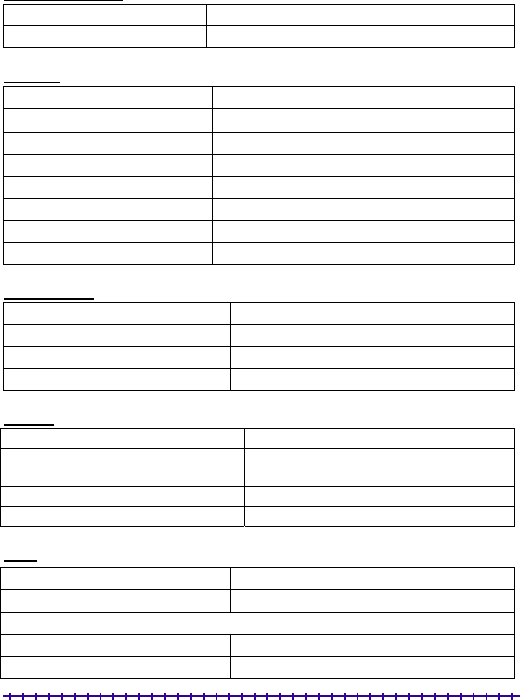
29
GST8000 SPECIFICATIONS
Physical Parameters
Enclosure dimensions 160(L)*115(W)*70(H)
Weight 1000g
Electrical
DC Supply voltage 12V
DC Tolerance voltage 9V-16V
Current (GPRS online) 45mA
Current (GPRS transmission) 100mA
Current (GPRS Peak) 140mA
Current (Sleep) 25mA (GPS and Satellite module are off)
Current (SBD standby) 120mA
Current (SBD transmit) 200mA
Backup Battery
Internal for emergency report
Battery type 6V (2 pcs battery)
Battery capacity 1.3A/H
Charge type Built-in charge circuit
GPRS*
Frequency Range (MHz) 850/900/1800/1900
GPRS connectivity GPRS multi-slot class 10
GPRS mobile station class B
SIM card interface 3V
Antenna Impedance 50ohms
GPS*
Channels 20 parallel tracking
Frequency L1-1575 MHz
Sensitivity
Tracking -159 dBm
Acquisition (Cold start) -142 dBm
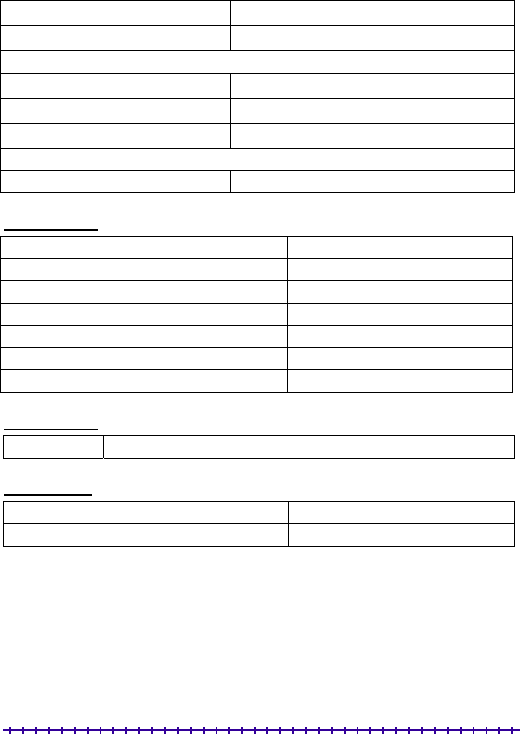
30
Position accuracy (Horizontal) <2.5m CEP autonomous
<2.0m CEP SBAX
Time to first fix
Hot start 1 <1s
Warm start 2 <32s
Cold 3 <35s
Standard GPS software
NMEA message switchable GGA, GSA GSV, VTG, RMC, GLL
Satellite module
DC supply voltage 5V
Baud Rate 19200
Frequency range 1616 MHz to 1626.5 MHz
Input/Output Impedance 50Ω
Multiplexing Method TDMA/FDMA
Duplexing Method TDD (Time Domain Duplex)
Average Power during a transmit slot (max) 1.6W
Communication
GPRS \SMS\USB
Environmental
Operating Temperature -20°C to +55°C
Storage Temperature -40°C to +85°C
PACKING LIST
1. Unit
2. Main wire harness
3. User manual
4. Valet & LED wire
5. PC-setup Cable
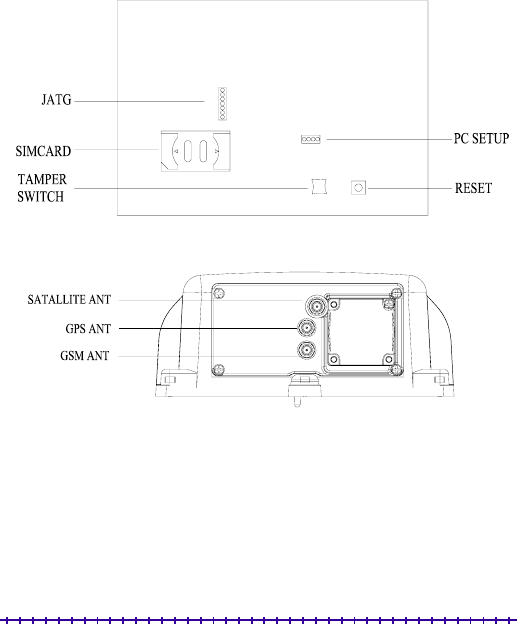
31
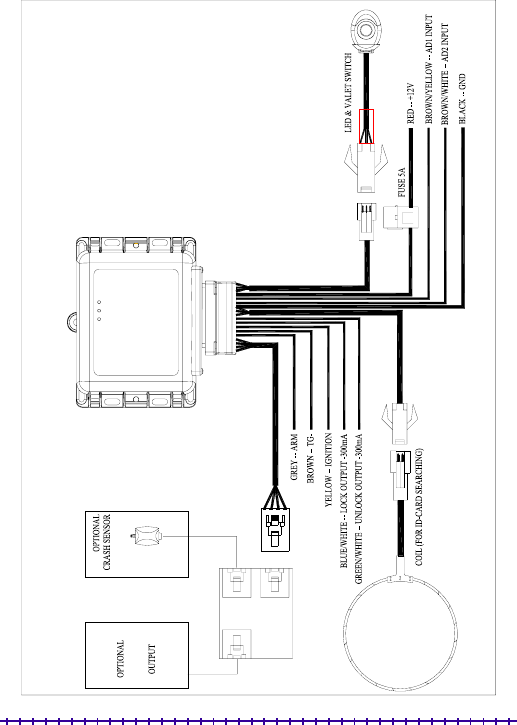
32

33
Federal Communications Commission (FCC) Statement
15.21
You are cautioned that changes or modifications not expressly approved by the part
responsible for compliance could void the user’s authority to operate the equipment.
15.105(b)
Federal Communications Commission (FCC) Statement
This equipment has been tested and found to comply with the limits for a Class B digital
device, pursuant to part 15 of the FCC rules. These limits are designed to provide
reasonable protection against harmful interference in a residential installation. This
equipment generates, uses and can radiate radio frequency energy and, if not installed and
used in accordance with the instructions, may cause harmful interference to radio
communications. However, there is no guarantee that interference will not occur in a
particular installation. If this equipment does cause harmful interference to radio or
television reception, which can be determined by turning the equipment off and on, the user
is encouraged to try to correct the interference by one or more of the following measures:
-Reorient or relocate the receiving antenna.
-Increase the separation between the equipment and receiver.
-Connect the equipment into an outlet on a circuit different from that to which the receiver
is connected.
-Consult the dealer or an experienced radio/TV technician for help.
This device complies with part 15 of the FCC Rules. Operation is subject to the condition
that this device does not cause harmful interference.
FCC RF Radiation Exposure Statement:
1. This Transmitter must not be co-located or operating in conjunction with any other
antenna or transmitter.
2. This equipment complies with FCC RF radiation exposure limits set forth for an
uncontrolled environment. This equipment should be installed and operated with a
minimum distance of 20 centimeters between the radiator and your body.